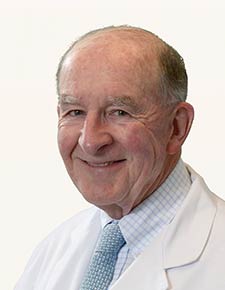Torn Pectoral Muscle: Pectoralis Major Injuries
Summary: This article discusses pectoralis major injury causes, signs, diagnosis, and available treatments. It reviews both nonsurgical and surgical treatment options, provides an overview of the surgical repair technique and describes the normal recovery period.

In this article:
Anatomy
The pectoralis major is a powerful chest muscle that causes the arm to move forward, rotate inward and move closer to the body. The muscle originates from two points: the sternum (breastbone) and the clavicle (collarbone). These two sections of the muscle come together into the pectoralis major tendon, which connects the muscles to the humerus bone of the upper arm, near the biceps tendon.
What is a torn pectoral muscle?
Injuries to the pectoralis major muscle and tendon are relatively rare, but they are becoming an increasingly frequent cause of disability. Although injuries can occur anywhere along the length of the muscle, the most frequent sites of damage are at the tendon and the area where the muscle and tendon meet (the myotendinous junction).
What causes pectoralis major tendon injuries?
The pectoralis major is typically injured when the muscle contracts while the muscle is stretching out, also known as an eccentric contraction. This most frequently occurs when the arm is extended and externally (outwardly) rotated. A ruptured pectoralis major tendon (sometimes referred to as a “pec tear”) occurs most frequently in men aged 20 to 40 while performing a bench press. Other activities commonly associated with pectoralis major injury include skiing, football, wrestling, rugby and direct trauma.
What are the symptoms of a torn pectoralis major?
Symptoms of a pectoral muscle rupture or tendon rupture include sudden onset of pain in the chest and upper arm, bruising and weakness. Some people may also feel a “pop” in the upper arm when the injury occurs. There may also be a visible change to the contour of the upper arm and armpit. Additionally, many people experience pain and weakness when attempting to bring the arm forward and rotate inward.
How is a torn pectoralis major tendon diagnosed?
This injury can often be identified through a physical examination from a sports medicine physician. There is often a change in the shape of the chest wall and armpit on the injured side, as well as swelling and bruising. Ultrasound performed by a skilled practitioner can be helpful in making the diagnosis. Dedicated magnetic resonance imaging MRI of the chest and upper arm is the standard for determining the presence and extent of injury.
How is a pectoralis major tendon injury treated?
The treatment of pectoralis major injuries depends on the extent of the injury and the patient's health. Minor injuries to the muscle and injuries in elderly patients are generally treated with pain medications and physical therapy. In contrast, complete or near-complete ruptures of the tendon or myotendinous junction in younger and athletic patients require surgery to restore function.
What is the surgery for a torn pectoralis major tendon?
Surgery involves repairing the ruptured tendon back to its original location on the upper arm. This is completed by making an incision on the upper arm near the armpit and sewing the tendon to small plastic screws or metal buttons placed in the arm bone (humerus). Occasionally, a tendon graft is needed to complete the repair if it is an old or particularly severe injury.
What is the recovery time for pectoralis major surgery?
After surgery, patients are usually immobilized in a sling for four to six weeks. Carefully instructed passive and active exercises are added over the following months, and light weightlifting is allowed at approximately four months. Patients typically return to competitive activity around six months after surgery.
Key takeaways
- Pectoralis major tears often happen during eccentric muscle contractions, especially during bench pressing or contact sports.
- Symptoms include sudden pain in the chest or upper arm, bruising, weakness, and visible changes in the arm or armpit.
- Diagnosis is typically made through a physical exam and confirmed with imaging like ultrasound or MRI.
- Minor injuries may be treated with rest and therapy, while complete tears in active individuals usually require surgery.
- Recovery after surgery involves sling use, gradual rehab, and a return to full activity in about six months.
References
- Apostolakos JM, Brusalis CM, Uppstrom T, R Thacher R, Kew M, Taylor SA. Management of Common Football-Related Injuries About the Shoulder. HSS J. 2023 Aug;19(3):339-350. doi: 10.1177/15563316231172107. Epub 2023 May 20. PMID: 37435133; PMCID: PMC10331269. https://pubmed.ncbi.nlm.nih.gov/37435133/
- Cordasco FA, Mahony GT, Tsouris N, Degen RM. Pectoralis major tendon tears: functional outcomes and return to sport in a consecutive series of 40 athletes. J Shoulder Elbow Surg. 2017 Mar;26(3):458-463. doi: 10.1016/j.jse.2016.07.018. Epub 2016 Sep 30. PMID: 27697455. https://pubmed.ncbi.nlm.nih.gov/27697455/
- Halpern BC, Chaudhury S, Rodeo SA. The role of platelet-rich plasma in inducing musculoskeletal tissue healing. HSS J. 2012 Jul;8(2):137-45. Doi: 10.1007/s11420-011-9239-7. Epub 2012 Jan 18. PMID: 23874254; PMCID: PMC3715623. https://pubmed.ncbi.nlm.nih.gov/23874254/
- Rodeo SA. Orthobiologics: Current Status in 2023 and Future Outlook. J Am Acad Orthop Surg. 2023 Jun 15;31(12):604-613. doi: 10.5435/JAAOS-D-22-00808. Epub 2023 May 1. PMID: 37130369. https://pubmed.ncbi.nlm.nih.gov/37130369/



